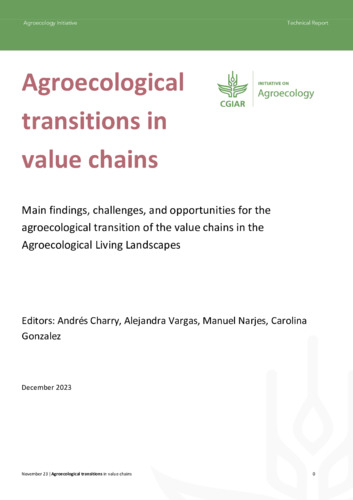Agroecological transitions in value chains: Main findings, challenges, and opportunities for the agroecological transition of the value chains in the agroecological living landscapes
This report summarizes the main findings and insights obtained from the various agroecological value chain analyses conducted in the different Agroecological Living Landscapes (ALL) that take part of the CGIAR Agroecology Initiative (AE-I).
The document includes a synthesis of 10 value chains analyses in specific subregions from 6 countries, which represent a wide range of political, agroecological, socioeconomic and cultural conditions: a dairy value chain in Burkina Faso;
a groundnut value chain in India; value chains of mango and of green leafy vegetables in Kenya; a cacao value chain in Peru; olives, sheep and honey value chains in Tunisia, and sorghum and poultry value chains in Zimbabwe.
As the value chains analyzed presented diverse levels of development, the AE-I teams from each country adjusted the research approaches, which in turn provided different types of findings and insights, nevertheless, in this report we present the information for each case in seven subchapters (one per value chain or region of interest) using a semi-consistent structure which includes a brief presentation of the regional context, key information regarding the value chain operation in the region and country, a value chain map showing the actors and product flows, and an analysis of the presence, relevance or potential of agroecological principles and practices for each case.
These are followed by a final chapter including conclusions, learnings and recommendations that highlight the common factors that may promote or hinder the value chain’s agroecological transition. These include the current degree of integration of the agroecological principles and the apparent conditions and factors that have driven or limited their adoption. Specific opportunities for investment and improvements along the value chain, such as service and input provision, better integration of livestock and crop systems, improved technologies and practices for processing and aggregation, and market development for agroecological products. These opportunities are paired with specific challenges or trade-offs, for which potential mitigation actions are briefly discussed.
In that sense, this report presents a first characterization of the initial status of the different value chains under intervention through the AE-I, a repository shared lessons, perspectives, and a point of reference for assessing the progress of the interventions of the initiative that reshape the value chains by enhancing the agroecological principles

